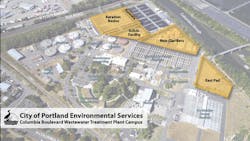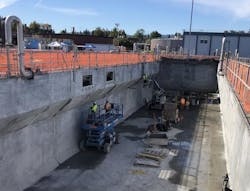$400M in improvements underway for Portland WWTP
The city of Portland’s Bureau of Environmental Services is constructing the largest set of upgrades to its main wastewater treatment plant in half a century, investing more than $400 million in projects towards resilience and efficiency.
The improvements will protect water quality, add seismic resilience to key portions of the plant, and replace equipment and buildings that have reached or exceeded their intended life span.
“Every Portland resident, business and visitor depends on the treatment plant operating continuously every day, throughout the year, and through all weather conditions,” said commissioner Mingus Mapps. “These upgrades will help continue reliable service that protects our environment, public health and worker safety.”
Environmental Services plans to complete the set of projects, collectively called the Secondary Treatment Expansion Program (STEP Program), by 2024.
Construction practices will focus on environmental stewardship, with more than 90 percent of construction waste slated for recycling, green roofs installed on new structures, energy-efficient structures and equipment used and other practices. In addition, Environmental Services is working with its contractors to encourage and cultivate a more diverse workforce in the construction trades.
As part of this strategy, the STEP Program is implementing an additional program to provide workers with the tools and support necessary to create and maintain a safe, inclusive, and productive environment. Environmental Services, its contractor, and members of the community and construction trades meet monthly to review data and provide advice on the employment of women and people of color in apprenticeships, workforce, and subcontracting roles on the projects.
The main features of the STEP Program are:
- Seismically-resilient clarifiers. The city is building two new clarifiers that are deeper and wider than the existing set of eight clarifiers and will be seismically reinforced. These secondary treatment clarifiers add capacity to treat wastewater during storms and are mandated to be completed by 2024 by the Oregon Department of Environmental Quality.
- Seismically-resilient solids handling building. The new solids building will be seismically resilient and have a green roof, better ventilation, and more efficient equipment. The equipment will remove at least 30 percent more water from the solids, which will in turn reduce transportation costs and emissions.
- Aeration basin upgrades. The plant has eight aeration basins that use microorganisms or bus to break down organic components in wastewater. The basins’ surfaces are being cleaned and restored to extend the life of this essential equipment. This work cannot take place during wet weather when the plant may be at capacity treating combined sewer and stormwater, and so the work will take place over four summers.
- Healthier, energy-efficient workspaces. The STEP project will recycle more than 90 percent of construction waste as crews deconstruct older structures and equipment to make space for the new clarifiers and biosolids building. In addition, crews are building a new office building with a maintenance shop that will provide healthier work areas for essential workers and will be built to LEED-Gold standard for environmental and energy efficiency.
As the project progresses, Environmental Services is developing opportunities for additional environmental and fiscal benefit. For example, the project manager last month brokered an agreement to recycle and reuse soil and excavated material instead of sending it to the landfill. The material will instead be used by the Port of Portland, which received regulatory approvals through the Oregon Department of Environmental Quality for its use. That arrangement repurposes 10,000 cubic yards of excavated material, saves the City $670,000 and reduces climate and air pollution by avoiding emissions from hauling.
SOURCE: The City of Portland, Oregon


